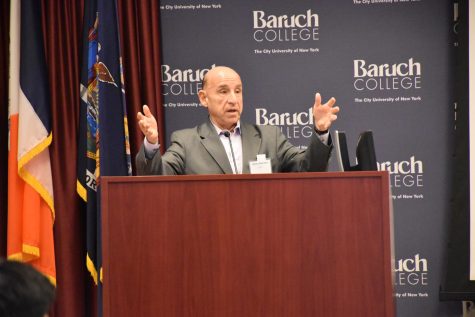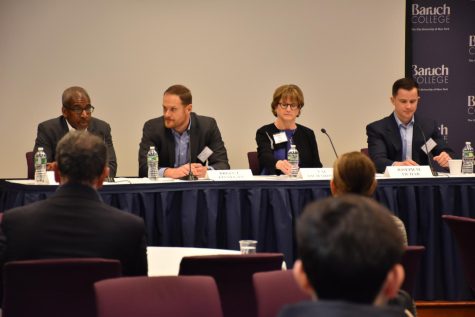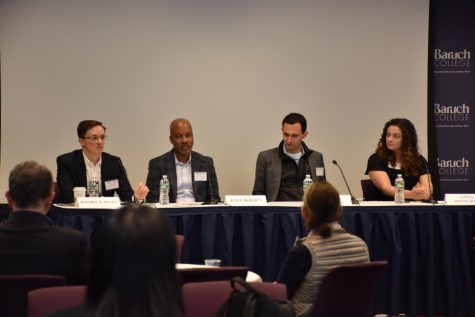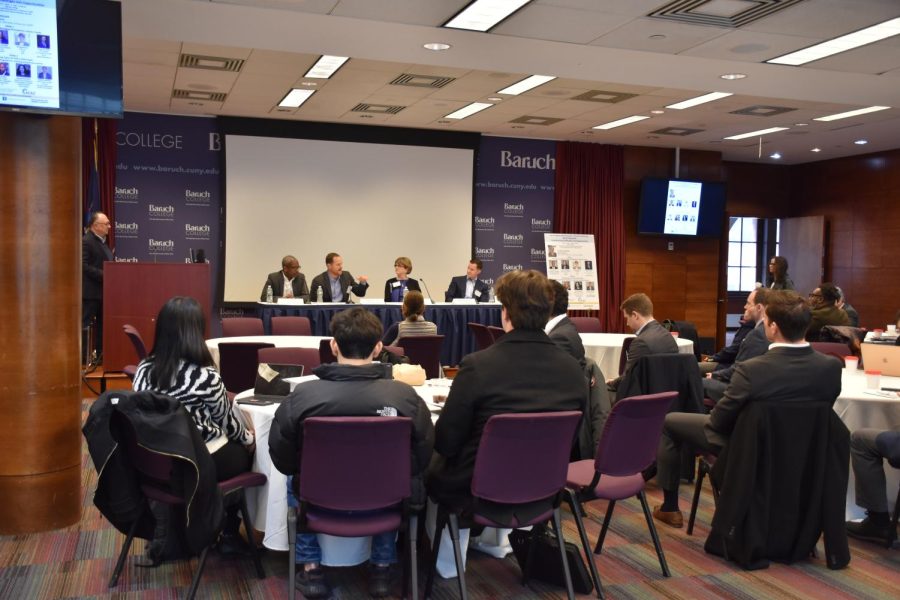Newman Institute and ICSC hold fourth annual joint conference
March 20, 2023
Baruch College’s Steven L. Newman Real Estate Institute and the International Council of Shopping Centers facilitated conversations about the retail and real estate industries with professionals, faculty and students at their fourth annual joint conference on March 7.
The institute and global trade association welcomed industry leaders from the private sector to the William and Anita Newman Conference Center to discuss trends in, and the future of, retail and real estate. Postponed from its original scheduled date in November 2022, the in-person event marked the conference’s first return since the COVID-19 pandemic.
“The last time we had the in-person conference, it was in fall 2019,” Newman Institute Chair Yildiray Yildirim said in his opening remarks. “It was on Halloween Day, and the pandemic really postponed us. Now we are back in person again, so it’s great to be back.”
In his keynote address, ICSC Chair Glenn Rufrano discussed developments in retail real estate over the past decade.
“In terms of just numbers, I’d say retail sales were up nicely, population was up nicely, supply was flat, e-commerce didn’t eat us,” Rufrano said. “And so what really happened was retailers closed too many stores or they didn’t open enough.”
The ICSC chair said that the pandemic “accelerated the benefit for retail by large” because it allowed retailers to utilize multiple methods of conducting sales. He added that it was “a plus for retail, in my view, and negative for all of us.”

The first panel, titled “The Future of Retail: Emerging Marketplaces Industry Trends,” welcomed Brixmor Chief Revenue Officer Brian Finnegan, ICSC Chief Operating Officer Valerie Richardson and Raider Hill Chief Operating Officer Joseph Tichar.
“I think the biggest thing that came from the pandemic was the recognition of the best way to get to the consumer was to have a store and investment in those stores,” Finnegan said, adding that “one thing that the pandemic did was really speak to the portability of the asset class.”
Lockdowns during the pandemic caused many stores to close their doors to customers while the demand for essential goods either remained or increased. Curbside pickups became a popular solution and essential function for many businesses such as Walmart Corp. to continue operations.
Although e-commerce appeared to threaten brick-and-mortar shops, corporations like Amazon.com Inc. and Walmart have reconsidered their business models to omit e-commerce planning.
E-commerce gained momentum as a new method for companies to scale their businesses, leaving ample room to determine the best strategy to market their products with profit in mind. Richardson said that there are many different strategies but nothing monumental.
Meeting customer demand has increased drastically with the help of e-commerce, but there are trade-offs. To meet customer demand in a timely fashion requires an extensive amount of processing before it reaches the customer. There is a lot of time between when the product is processed to when it is shipped and delivered. Hiccups can happen.
“The more times an item gets touched between bringing it into a store or warehouse and getting it to a consumer’s hands, the more opportunity there is for something to go wrong,” Tichar said. “Whether something happens to the good and becomes defective or theft or whether that’s from an employee or a shopper.”
The pandemic changed consumer behavior throughout the retail sector, widening the shopping experience. Richardson said she found it “weird” how sales of luxury goods “have just gone through the roof” over the pandemic, questioning how people could be willing to spend that kind of money without thinking about the status of their job and wage security.
Consumption behavior in the retail sector deviated, according to Richardson. There was an observable preference among the baby boomers to shop in person, while Generation Z consumers were open to shopping both in person and online.
“It’s just the changing nature of a retail shopping center,” Finnegan added.

The second panel, titled “Evolving Topics for ESG in Real Estate: Climate Policy, Regulations, and Reporting Requirements,” focused on efforts within the real estate industry to adhere to climate-conscious policies. Panelists included Kyle Borden, a sector leader for Ernst & Young; Anna Weingord, a sustainability specialist at Nuveen Real Estate; and Zachary Steinberg, the senior vice president of policy at the Real Estate Board of New York.
Borden discussed a draft disclosure proposal by the Securities and Exchange Commission that targets how real estate companies report climate-related disclosures, such as how much fossil fuels are consumed during operation. He said that the SEC’s goal with this proposal is to incentivize companies to provide useful information in their financial statements for environmentally concerned investors.
“A lot of companies are making statements,” Borden added. “Many are actually providing goals, and they’re saying we want to be net-zero by 2024 or 2030. What does all that mean? If you look at the different stakeholders, all the different costs of the financial statements, it’s not just investors but it’s your lenders. It’s your employees. It’s your tenants. That’s going to be a big thing for them.”

Steinberg said that real estate in New York City is “well positioned” to deal with reforms in public policies that address energy and water consumption. He added that reforms initiated by New York Gov. Kathy Hochul to remove fossil fuel systems from existing buildings and start new construction were informed by data collected by the real estate board for over a decade.
Weingord said that there’s an expectation to underwrite climate risk in investments for stakeholders. There will also be a “tipping point” where there will be “ground discounts on properties that will not be able to transition to a low-carbon economy.”
“It’s really about underwriting that risk now [and] understanding what the potential costs of transitioning that building to be net-zero,” Weingord said, “whether that’s going to be electrifying deep-energy efficiency measures, installing on-site renewables — regardless of whether you’re choosing to enter that into the budget for next year or just understand the cost of what that would be.”
The panelists said there will be challenges as the city transitions to follow these reforms. As Steinberg said, “politics is not a rational space.”








